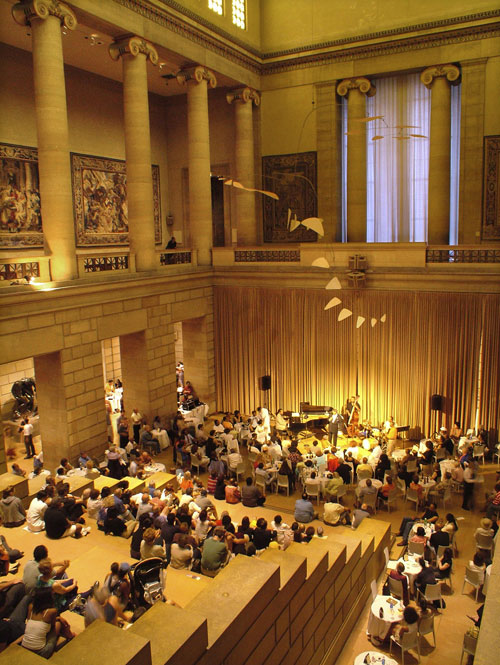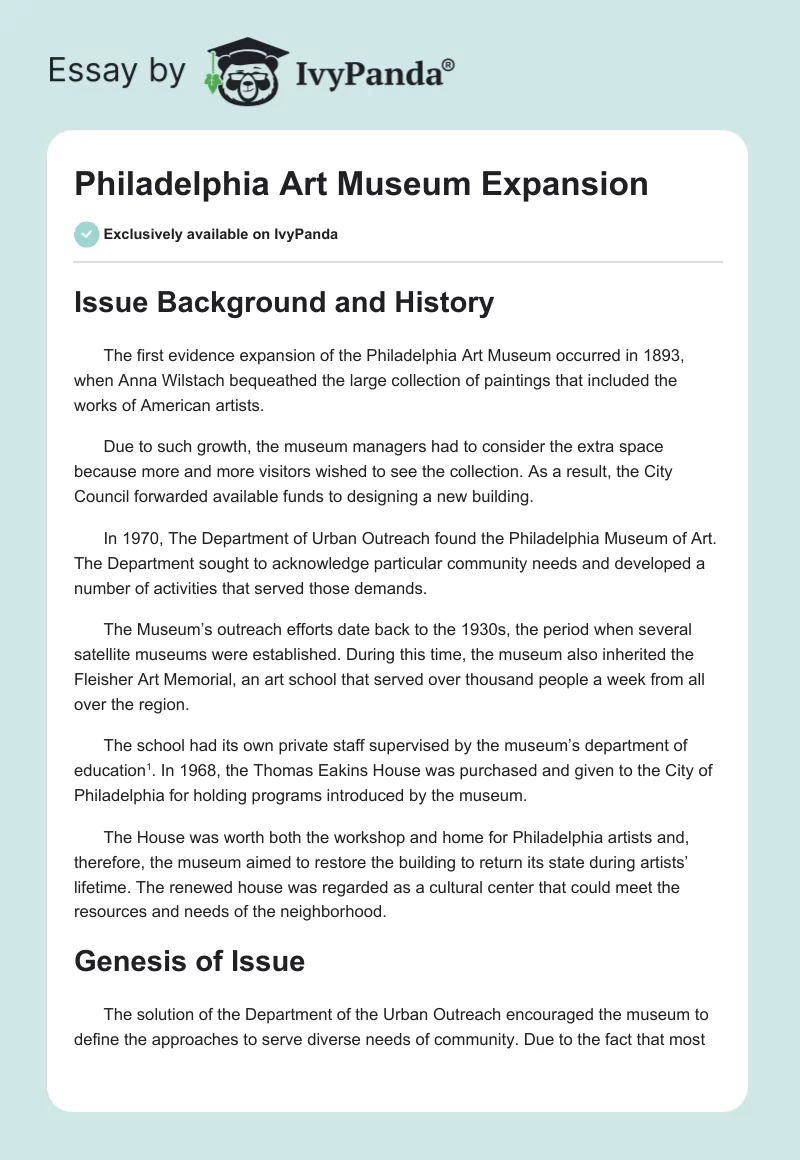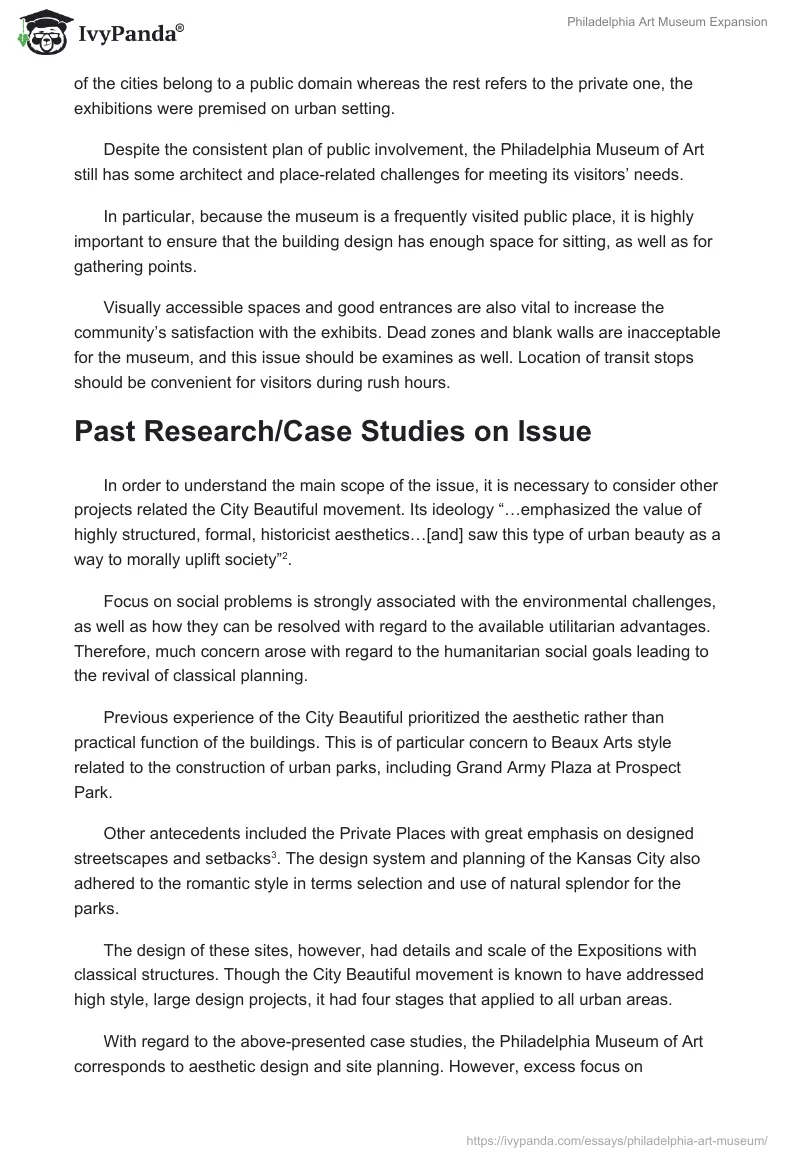Issue Background and History
The first evidence expansion of the Philadelphia Art Museum occurred in 1893 when Anna Wilstach bequeathed the large collection of paintings that included the works of American artists.
Due to such growth, the museum managers had to consider the extra space because more and more visitors wished to see the collection. As a result, the City Council forwarded available funds to design a new building.
In 1970, The Department of Urban Outreach founded the Philadelphia Museum of Art. The Department sought to acknowledge particular community needs and developed a number of activities that served those demands.
The Museum’s outreach efforts date back to the 1930s, the period when several satellite museums were established. During this time, the museum also inherited the Fleisher Art Memorial, an art school that served over thousand people a week from all over the region.
The school had its own private staff supervised by the museum’s department of education. In 1968, the Thomas Eakins House was purchased and given to the City of Philadelphia for holding programs introduced by the museum.
The House was worth both the workshop and home for Philadelphia artists and, therefore, the museum aimed to restore the building to return its state during artists’ lifetime. The renewed house was regarded as a cultural center that could meet the resources and needs of the neighborhood.
Genesis of Issue
The solution of the Department of the Urban Outreach encouraged the museum to define the approaches to serve diverse needs of community. Due to the fact that most of the cities belong to a public domain whereas the rest refers to the private one, the exhibitions were premised on urban setting.
Despite the consistent plan of public involvement, the Philadelphia Museum of Art still has some architectural and place-related challenges for meeting its visitors’ needs.
In particular, because the museum is a frequently visited public place, it is highly important to ensure that the building design has enough space for sitting, as well as for gathering points.
Visually accessible spaces and good entrances are also vital to increase the community’s satisfaction with the exhibits. Dead zones and blank walls are unacceptable for the museum, and this issue should be examines as well. Location of transit stops should be convenient for visitors during rush hours.
Past Research/Case Studies on the Issue
In order to understand the main scope of the issue, it is necessary to consider other projects related the City Beautiful movement. Its ideology “…emphasized the value of highly structured, formal, historicist aesthetics…[and] saw this type of urban beauty as a way to morally uplift society”.
Focus on social problems is strongly associated with the environmental challenges, as well as how they can be resolved with regard to the available utilitarian advantages. Therefore, much concern arose with regard to the humanitarian social goals leading to the revival of classical planning.
Previous experience of the City Beautiful prioritized the aesthetic rather than practical function of the buildings. This is of particular concern to Beaux Arts style related to the construction of urban parks, including Grand Army Plaza at Prospect Park.
Other antecedents included the Private Places with great emphasis on designed streetscapes and setbacks. The design system and planning of the Kansas City also adhered to the romantic style in terms selection and use of natural splendor for the parks.
The design of these sites, however, had details and scale of the Expositions with classical structures. Though the City Beautiful movement is known to have addressed high-style, large design projects, it had four stages that applied to all urban areas.
With regard to the above-presented case studies, the Philadelphia Museum of Art corresponds to aesthetic design and site planning. However, excess focus on beautification prevents the building from ensuring enough practical space for visitors to use.
Spatial utilization, therefore, should also be enhanced for the attendees to enjoy the exhibition displays in the most effective way. Hence, the building should reconsider its social and political purpose to define how the above-enumerated issues could be resolved.
Design, Development, and Decision-Making Implications
Before establishing these requirements, the director of the museum should define what purpose is prioritized in developing new designs and engineering planning. Specific attention should also be given to the community audience, employment issues, and benefits that the museum receives.
Finally, once the purposes have been identified, the testing procedures need to be introduced. Because the museum lacks good sitting places and provides inaccessible spaces, some of the parts of the construction should be re-assessed in terms of appropriate re-allocation of the exhibits.
Role of Landscape Architects
The Philadelphia Museum of Art is considered one of the greatest successful projects of the City Beautiful movement that encouraged large-scale city plans. The project was initiated as soon as a team of architects created plan for the parkway.
The team included Paul Cret, Clarence Zantinger, and Horace Trumbauer, along with their partners Milton Medary and Charles Borie. The group worked on the parkway construction that presupposed a plan of a ceremonial boulevard restructuring diagonally throughout the city.
From 1911 to 1915, several plans had been adopted, and the designers working on the project decided to recreate the historical image of the Greek Acropolis through installation of temple forms connected by galleries.
With regard to the historical overview of the museum, the designed focused more representing the Greek ancient motives which led to certain place and space planning challenges.
Maintenance and Management Approaches
Museums usually require consistent building work to be done, as well as high-quality technical engineering services for installing, maintaining, and protecting the exhibition displays. In this respect, the lost cost and budgeting is not the case for evaluating the museum-related projects.
Controlling costs should be assigned to one person who takes control of the project management and is responsible for supervising costs, quality, and program accomplishment. The project managers should be aware of other operational budgets and requirements within the museum planning and establishment.
Service engineers should also be involved into place planning, particularly when it comes to electrical, mechanical, lighting, and planning services.
The duties of service engineers involve investigating and reporting on design and installation that ensures safety, convenience, safety, as well as life-cycle assessment of the proposed museum reconstruction.
The engineers should work in cooperation with architects and consultants to define appropriate proposals and include all possible costs and alternatives.
Preparing relevant calculations and following architects’ approvals must be considered. Finally, specifications, schedules, and drawings should also be provided to point out what could be corrected and which points should be left.
User/Use Analysis
The main purpose of the Department of Urban Outreach is to invite community in enjoying the collections presented in the museum. The museum, therefore, has a vast area and, therefore, some places might be utilized for parking the vehicles.
In order to preserve the Beaux Arts neoclassical style of the landscape, the designers could arrange the parking behind the main building, which both excludes the problem of overcrowded space in front of the museum entrance and create a convenient service for the attendees.
Peer Reviews of Issue
Greater understanding of urban space planning creates critical focus on the importance of place in the welfare of the city. In this respect, landscape designers and architects insist that “…space should not be merely thought of as physical – place…but as an entity actively produced by society”.
Therefore, public spaces that serve community goals is not an innovative idea; nevertheless, city planners and urban reformers should underscore the cultural assimilation and public health perspectives as the leading steps of plan consideration. In the twenty-first century, the supports of public places support idea of related property values contributing to increase in physical activities, particularly among youth. Recent shifts to political and economic realms increased mobility and flexibility of financial resources, as well as developed new communication channels.
Therefore, the project planning of the Philadelphia Art Museum should be oriented on growth promotion and life quality improvement.
Criticism
With regard to the identified public space planning challenges, the Philadelphia Art Museum should be more concerned with external landscape projecting that could improve adequate flow of visitors. Ensuring several entrances will significantly contribute to the convenience in attending various exhibitions.
In addition, there should be specific regulations at each entrance to control the number of individuals entering and leaving the building. Introducing video control can also improve safety and protection.
Significance and Uniqueness of Issue
The Philadelphia Museum of Art has a long history of design and construction because it adapted to new social needs of the community. The attention is given to both the exhibition collections of the institution and the architecture and space planning.
Therefore, the uniqueness of the issues lies in the possibility of combining these two areas to improve the quality of services and increase the convenience of visiting museums.
Because museum exterior and interior have been changed with the occurrence of new collections, the urban growth orientation is introduced by the City Beautiful movement. As a result, its primary challenge lies in further accommodations to the fast-growing demands.

Limitations/Problems
Because the building was constructed more than century ago, the changes to the interior design are limited only to development of technologically advanced equipment.
Style variations are also possible, along with the allocation of exhibitions. As per the exterior, more options are available for reconstruction in accordance with the public needs.
Implications/Recommendations
In order to improve the museum’s functionality and increase protection and safety of visitors, specific emphasis should be placed on development of engineering plans and services.
This is of particular concern to reconsidering spatial allocation for ensuring parking zones, as well as developing more sitting in the park behind the museum entry.
Conclusion
The Philadelphia Museum of Art is considered one of the largest museums in the city that introduces multiple exhibitions. Its design style and landscape planning contribute to the community’s needs.
Nevertheless, several introductions, such rearrangement of the parking zone, and development of the gathering points for the visitors should be introduced.
Works Cited
Council on Museums and Education in the Visual Arts. The Art Museum as Educator: A Collection of Studies as Guides to Practice and Policy. US: University of California Press, 1978. Print.
Pregil, Philip and Nancy Volkman. Landscapes in History: Design and Planning in the Eastern and Western Traditions. US: John Wiley and Sons. Print. 584.
Lord Barry, Lord Gail Dexter, and Lindsay Martin. Manual of Museum Planning: Sustainable Space, Facilities, and Operations. US: Rowman Altamira, 2012. Print.
Lord, Gail, and Barry Lord. The Manual of Museum Planning. US: Rowman & Littlefield. 1999. Print.
Schmidt, Stephan, and Jeremy Nemeth. “Space, Place and the City: Emerging Research on Public Space Design and Planning.” Journal of Urban Design 15.4 (2010): 453-457.
Steffensen-Bruce, Ingrid A. Marble Palaces, Temples of Art: Art Museum, Architecture, and American Culture, 1890-1930. Bucknell University Press, 1998. Print.
“The Early Decades: 1877-1900”. Philadelphia Museum of Art. 2012. Web. https://www.philamuseum.org/information/45-224-20.html


